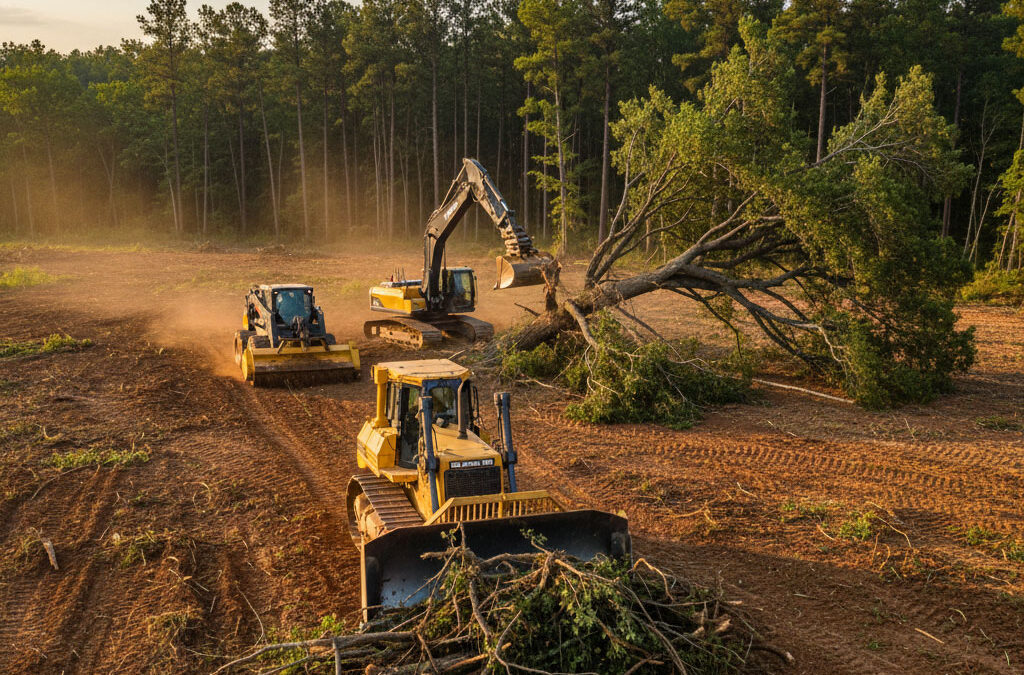Wildfires are a growing threat to residential areas, particularly in regions with dry climates and dense vegetation. Overgrown brush, dead trees, and unmanaged undergrowth provide fuel for fires, allowing flames to spread quickly and endanger homes, families, and communities.
Implementing land clearing strategies before fire season is a critical step in reducing these risks and protecting property.
Land clearing is more than just tidying up a yard—it is a proactive safety measure. By removing excess vegetation, homeowners create defensible spaces that slow wildfire spread, improve accessibility for emergency responders, and reduce the chances of catastrophic damage.
Understanding the benefits of land clearing is essential for anyone looking to safeguard their property and community.
Reduce Fuel for Fires
Dense vegetation and accumulated brush act as easy fuel for wildfires, increasing their intensity and speed. Land clearing removes this risk by reducing combustible material.
- Cut down dead trees, shrubs, and undergrowth.
- Remove dry grasses and fallen leaves from around structures.
- Maintain a safe perimeter of cleared land around homes.
Reducing available fuel significantly lowers the chance of fires spreading to residential structures. Homes and yards become safer when excess vegetation is actively managed.
Create Defensible Spaces
Defensible spaces are buffer zones between structures and surrounding vegetation. Land clearing ensures these zones are effective in preventing fire damage.
- Clear at least 30 feet of space around homes and buildings.
- Thin tree canopies to prevent fire from jumping from one tree to another.
- Keep fire-resistant landscaping and gravel zones near property.
Defensible spaces give firefighters a better chance to protect homes and control wildfires. Proper planning of these zones is a critical element of property safety.
Improve Emergency Access
Thick vegetation can block roads, driveways, and fire lanes, making it difficult for emergency responders to reach threatened areas. Land clearing keeps access routes open and navigable.
- Maintain clear driveways and paths for fire trucks and emergency vehicles.
- Remove obstacles such as fallen branches or dense undergrowth.
- Ensure property entrances and gates are clearly marked and accessible.
Accessible routes allow faster emergency response times and reduce the risk of property loss. Emergency personnel can operate more effectively in cleared areas.
Reduce Heat and Fire Intensity
Overgrown brush traps heat and acts as a ladder fuel, carrying fire from the ground to tree canopies. Clearing vegetation disrupts this process and lowers fire intensity.
- Remove low-hanging branches and thick undergrowth.
- Thin dense shrub clusters to allow airflow and sunlight penetration.
- Spread mulch or gravel in cleared areas to reduce flammable material.
Lower fire intensity helps protect homes and makes wildfires easier to manage. Cleared landscapes create safer microenvironments that prevent fires from escalating.
Support Community and Ecosystem Health
Land clearing benefits both the local community and the environment when done responsibly. It reduces wildfire risk while preserving healthy ecosystems and wildlife habitats.
- Retain healthy, strategically placed trees and native plants.
- Remove invasive or highly flammable species that increase fire danger.
- Use cleared material as mulch or erosion control to support the environment.
Responsible land management protects property while maintaining ecological balance. Communities become safer, and ecosystems remain resilient against fire threats.
Protect Homes and Communities from Wildfire Damage
Land clearing is a vital tool for wildfire prevention in residential areas. By reducing fuel, creating defensible spaces, ensuring emergency access, lowering fire intensity, and supporting ecosystem health, homeowners can significantly reduce the risk of catastrophic fire damage.
Properly managed landscapes not only protect property and lives but also promote safer, healthier, and more resilient communities. Taking proactive steps now ensures long-term safety and peace of mind during fire season.

